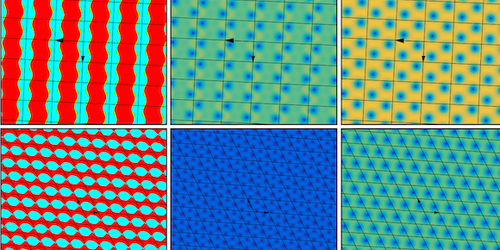Superconductor Vortices Visible as Stripes
In a nematic superconductor, electron pairs are bound more strongly in one, spontaneously chosen, lattice direction than in the others. This rotational symmetry breaking of the pairs’ wave function is just one of this type of superconductor’s unusual properties. A leading candidate to exhibit nematic superconductivity, copper-doped bismuth selenide, is also predicted to sustain surface charge-carrying quasiparticles known as Majorana fermions, which researchers think could be used for superconducting quantum technologies. What’s more, nematic superconductors harbor topological solitons known as skyrmions, whose complexity gives them many ways to arrange themselves and whose small size and low energy have attracted interest for data storage technologies. Now Thomas Winyard of the University of Edinburgh, UK, and colleagues have calculated the various skyrmion configurations that could arise in a nematic superconductor [1, 2].
The physicist Tony Skyrme came up with the concept of a skyrmion in 1961 when working on a particle physics problem. In the 2000s, the quasiparticle was then linked to condensed-matter systems when it was discovered that quasiparticles could also be used to explain magnetic vortices in certain thin films.
Incorporating skyrmions into the macroscopic Ginzburg-Landau theory of superconductivity, Winyard and colleagues predict that, for certain strengths of an applied magnetic field, skyrmions in a nematic superconductor arrange in striped patterns. Skyrmion patterns affect how the local magnetic field is distributed within the superconductor, and for the striped arrangement the patterns give rise to a characteristic two-peaked field that can be probed using muon spin resonance ( 𝜇SR). Given that 𝜇SR is standard technique, the team proposes that it could be used to help boost the low number of strong candidates for nematic superconductivity.
–Charles Day
Charles Day is a Senior Editor for Physics Magazine.
References
- M. Speight et al., “Magnetic response of nematic superconductors: Skyrmion stripes and their signatures in muon spin relaxation experiments,” Phys. Rev. Lett. 130, 226002 (2023).
- M. Speight et al., “Symmetries, length scales, magnetic response, and skyrmion chains in nematic superconductors,” Phys. Rev. B 107, 195204 (2023).




